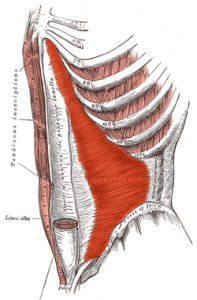Abdominal Muscles & Transverse Abdominis Function: An Overview
There are four abdominal muscles and this post will cover the transverse abdominis function.
Abdominal muscles work together to facilitate spinal movement as well as to constrain and affect the abdominal contents.
While this post will focus on the transverse abdominis I’ll cover the other three before we get to the topic at hand.
The four abdominal muscles are the rectus abdominis, the internal and external obliques, and the star of today’s post, the transverse abdominis.
Technically there are eight abdominal muscles because they come in pairs.
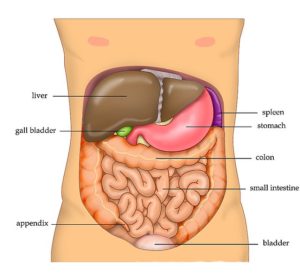
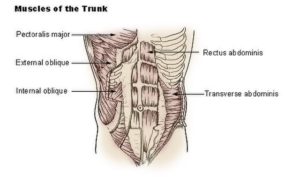
The rectus abdominis is the most surface of the abdominal muscles. Most people have a reference for the rectus abdominis as the six-pack muscle.
Rectus abdominis connects from the base of the rib cage to the pubic bone and draws the pelvis towards the ribs and the ribs towards the pelvis.
It is actually a ten pack but the top six are the ones we see when we put in the work to make them hard and big enough to pop out from the tendonous insertions that sit between the muscles.
For what it’s worth, I am not a fan of the six-pack. Hard muscle isn’t the healthiest option.
The internal and external obliques are twisting muscles among other functions depending on whether they work together or individually.
They rotate the trunk, flex the trunk, and increase the tone of the other abdominal muscles.
Their actions along with the other abdominal muscles create pressure in the abdomen which aids in things like forced exhalation, peeing, pooping, and also labor.
But let’s get to the star of the show.
Transverse Abdominis Function
This post and video above cover the transverse abdominis function and its role in helping with back pain.
The transverse abdominis, referred to as the corset in pilates, is the deepest of the abdominals.

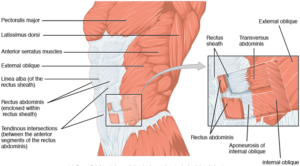
It runs from the belly button up to the rib cage.
Below the rib cage, the transverse switches places, and the rectus abdominis moves behind the transverse to attach to the pubic bone.
The transverse abdominis wraps horizontally from the back of the body to the front.
There is one transverse muscle on each side joined by a fascial sheet that connects them and allows them to act as one solid muscle.
Along with other core muscles, the main function of the transverse abdominis is to maintain the tone of the abdominal organs.
They hold the organs in place and support the trunk helping to stabilize the spine and pelvis.
This is essential as they stabilize the trunk and pelvis before movement of the limbs occurs. Lack of tone allows for unstable movement which can lead to the pain we are trying to avoid.
When one side works it bends and rotates the body to the side.
And whenever we employ deep breathing, for sports or what have you, the transverse abdominis muscle gets involved.
To reiterate— throwing up, coughing, defecating, and also forced exhalation— like playing a wind instrument, blowing up balloons or moving heavy objects are all aspects of the transverse abdominis function.
Pushing out an exhale is an excellent way to feel this muscle at work as the essential transverse abdominis function is to compress the abdomen.
Transverse abdominis has an interplay with many core components— the spine, the muscles surrounding the spine, the psoas, and the other abdominal muscles as well.
Your core is the essential originator of most body movements. It is also a determinant of the quality of an individual’s posture, aligning the trunk if the muscles all have their proper tone.
Balanced Core Tone Is Essential
Because of this, building tone in the core is a good way to help with lower back pain.
While this is true, none of the abdominal muscles actually connect to the spine.
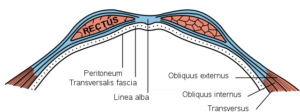
But the fascia (the connective tissue that wraps the whole body in many different ways) of the transverse abdominis goes all the way around to the outside attachments of the lumbar spine.
The transverse abdominis attaches at the bottom of the rib cage and the top of the iliac crest of the pelvis.
The lower part of the muscle runs out of the iliac crest and wraps itself into the inguinal ligament which, among other things, straps down the psoas major.
Decent muscle tone in the transverse abdominis and the internal and external obliques keep the organs in place and supports the lumbar spine helping considerably with back pain relief.
Low tone in these muscles allows for the organs to spill out of the abdominal cavity.
Too much tone, which is possible but I don’t see it much, can lead to a hernia, hemorrhoids, urinary incontinence, and other digestive troubles.
The transverse abdominis is a back pain muscle. When it lacks tone it can’t stabilize against impending movement.
So many pain issues all through the body are related to a lack of tone.
Laxity in ligaments is a big issue as well as a lack of tone in muscles that fail to stabilize the body when it is about to move.
While there isn’t always anything to be done about ligaments that lack tone almost everyone— with work— can bring tension to otherwise weak muscles.
Balanced tone improves transverse abdominis function.

